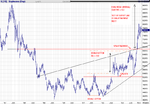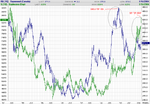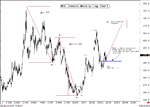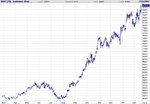For anyone interested, I have copied the article here.. (hope that's OK)
Dear Daily Reckoning reader,
Stock analysts often say that "When Wall Street
sneezes, the City catches a cold."
Well watch out, Britain! Because the US has caught
the flu - Japanese flu to be exact.
Japanese investors have been stuck in a bear market
for almost 14 years now. The parallels between how
they got there – and how Wall Street has suffered
since the Bubble of 1996/2000 – are eerie, to say the
least...
** Between 1971 and 1985, the Japanese stock market
went up about 500 per cent.
** The US bull market began 10 years later – and from
1981 until 1995, US stocks went up 500 per cent.
** In 1985, the Japanese market really took off –
tripling in the next 5 years. In 1995, the US market
really took off – tripling in the next 5 years.
** In 1990, the Japanese market peaked out and
started to fall. Eighteen months later, it was down
some 30 per cent.
** In 2000, the US market peaked out...and 18 months
later it was off some 30 per cent.
Spooky, don't you think?
But the parallels between Tokyo and Wall Street don't
end there...
Thirty-one months after the Nikkei peaked in 1990, it
bottomed at 14,194. It then rallied 50% over the next
13 months – before tumbling again.
Over on Wall Street, ten years later, the S&P 500
topped out at 1,552 in March 2000. Thirty-one months
later, it bottomed at 768. Over the following 14
months, it has rallied 47% to its current level.
This is more than coincidence. And if the parallels
hold from here, the prognosis for US stocks – and for
British investors who want to avoid catching the flu
– doesn't look good.
"The S&P's rally will end any day now," wrote Eric
Fry, our New York editor, on Tuesday. With America's
New Year reporting season almost upon us, you might
think Eric was making a pretty safe call.
But Eric predicts "the index will tumble about 24%
between now and April." His forecast is based on this
parallel with the Tokyo Nikkei - which is still
proving so painful to Japanese investors, 14 years
after it peaked.
"The Nikkei didn't rally by 50% just once," explains
Eric. "It launched three distinct 50% rallies...
** In 1995-6 it soared from 14,000 to 22,000, exactly
like the 1992 rally.
** Then, from late 1998 to 2000 it jumped 50% from
13,000 to 21,000...
** Before collapsing to 7,600 in April of last year."
It could never happen on Wall Street, of course. The
global economy's "single engine" is now reporting
plenty of positive numbers. Egged on by Dubya's tax
cuts and Greenspan's E-Z credit bubble, US investors
are piling back into the markets. The optimists are
sure they will triumph.
But Japanese investors felt just the same optimism
every time the Nikkei staged a rally. Even when it
crashed, they clung to hope like a flu victim
clutches his hot water bottle.
In September 2000, the Japan Times interviewed a 30-
year old stock investor from Saitama. Mr Nakamura had
watched his equity investments lose 500,000 yen in
just 9 months – equivalent to £31,850 in 2000 terms.
Yet Nakamura-san was still undaunted:
"The loss doesn't shock me," he told the paper. "I
actually wish I had more money now, because this is
the best time to buy stocks."
Bright guy. Reminds us not a little of today's bulls
on Wall Street and in the City.
And so we ask: Is today the best time for you to buy
stocks, dear reader? We doubt it – for reasons that
go far beyond the spooky stock index parallels we've
just described.
Japan also offers a scary insight into America's
future demographics – the "aging population" which
every commentator accepts will make economic recovery
even harder in the months and years to come. The
effects of this demographic shift on stock market
values is something we believe hasn't been explored
anywhere but in our new book, "Financial Reckoning
Day".
If you want to learn more about how the US economy is
"turning Japanese" – plus what you can do today to
protect yourself from the fallout in British shares
when it does – then we urge you to read it for
yourself today.
Because if the Dow Jones does chart a course
identical to the Nikkei's, it will fall to 8,000 by
this coming spring...on its way to 2,400 in April
2014.
That's some sneeze, dear reader, and Britain will
catch a very nasty cold.




